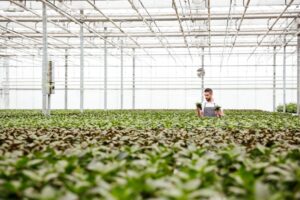Soil or earth is the primary source of life on this planet. It is our natural resource without which we would have no food to continue the existence of living beings. Can you imagine how dangerous it would be for us if this natural provider gets completely exhausted? Therefore, it is imperative to take care of the soil. The best solution to prevent such a crisis is regenerative agriculture. Also, by adding digitization to the organic practice, you shall have a perfectly eco-friendly and sustainable solution to farming.
The Existing State of Agriculture
There is no denying that agriculture is at the mercy of natural systems, and the natural systems are changing. Shifts in temperature and water availability are negatively impacting crop yields, jeopardizing the economic security of farmers. It’s a domino effect that has a crucial impact on every part of the food chain.
Extreme weather conditions like droughts and floods can cause significant damage to the farmers. Poor quality harvests and higher costs are impacting the price, quality, and quantity of the products. If this goes on, there is a high chance that the yields of different crops will decrease drastically. It is crucial to develop resilience from the ground up to make sure that the farmers are well-positioned down the line. This is where regenerative agriculture comes in. It is the key to making this possible.

Regenerative Agriculture – In Simple Terms
Regenerative agriculture is a modern approach to farming that aims to restore and enhance farm ecosystems. It is focused on soil health while sequestering CO2 from the atmosphere, and increasing farm biodiversity while improving water management in the process. This is beyond organic farming since it improves the resources used instead of reducing them. The end goal is to make the farmland much more healthy, productive, and diverse.
Regenerative farming is context-specific. Remember, there is no one-size-fits all approach because it depends on the unique conditions of every farm. There are different key principles and practices that are associated with management practices. Considering the practice level includes factors like conservation tillage, cover cropping, crop rotation, planned livestock, use of no synthetic fertilizers, and application of organic matter. These practices are guided by five crucial steps of regenerative agriculture. They include:
-
Minimal Disturbance to the Soil –
Soil supports a complicated network of microorganisms that offer several ecosystem services like the nutrient cycling, and carbon storage. Disturbing this through ploughing or tillage will set the system back.
-
Keeping the Soil Covered –
Bare soil has a higher risk of erosion because of the extreme heat, rain, and frost. If you grow a cover crop or add organic residue, you can protect it.
-
Growing a Wide Array of Crops –
Soil health improves when different types of crops are planted in it. By growing different types of crops, farmers can feed their soil the right amount of nutrients required for them to flourish.
-
Keeping the Living Roots within the Soil –
Living roots in the soil help in developing biodiversity, enhances fertility and increases water quality. Reintroducing the perennials is a quick way to integrate living roots year-round.
-
Integrating Animals –
By integrating crops and livestock within the same system through planned grazing, the farmers can dramatically increase soil fertility and reduce the requirement of synthetic inputs.
This approach to farming represents a modern opportunity for farmers. The recent drive to reduce the effects of climate change, combined with the soil’s capability to draw carbon from the atmosphere, means farmers engaged in regenerative agriculture can garner new revenue for climate efforts.
Ecological Impacts of Regenerative Agriculture:
Regenerative agriculture helps in improving soil organic matter and biodiversity. Therefore, it reduces the impact of erosion and degradation while also increasing the soil function. Healthy soils with good porosity have an essential role in reducing the impact of harsh weather conditions by absorbing and storing water that would run off otherwise. This reduces the impact of flooding on the field. The same pores allow roots to grow deep within the soil recover water at the time of a drought.
Financial Impacts of Regenerative Agriculture:
Apart from the ecological benefits, regenerative agriculture is also great for business. Regenerative farming is much more profitable than other farming methods. How? Lesser input costs, secure yields, higher natural capital, and higher production margins.
Regenerative agriculture has innumerable social impacts. We have to depend on healthy ecosystems to purify the air so that we can breathe, get clean drinking water, sequester carbon for climate regulation, and pollinate crops so that we don’t starve. Regenerative farming contributes to every one of the essential ecosystem services.
For accurate soil mapping and analysis, contact SoilOptix® today! Visit https://soiloptix.com/ for details.
